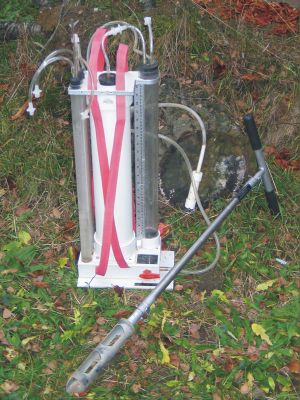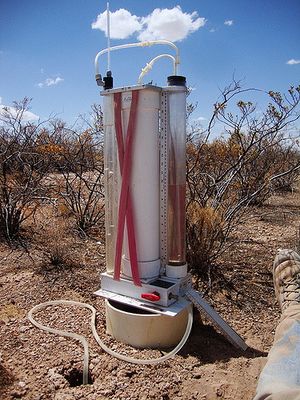Hydraulic Conductivity - Amoozemeter
Jump to navigation
Jump to search
The printable version is no longer supported and may have rendering errors. Please update your browser bookmarks and please use the default browser print function instead.
Parameter to be measured:
Hydraulic conductivity
Method:
Constant head permeameter: Measures infiltration rate within an auger hole up to a depth of 2 m and with extension set up to a depth of 4 m. A constant hydraulic head is kept in the auger hole which must be H/r >= 5 and the infiltration rate will be monitored until steady state flow is attained. Hydraulic conductivity will be calculated with the equation of Glover (Amoozegar, 1989b, 1993)
Equipment:
- Constant head permeameter with reservoir (with combined) Mariotte-bottle
- dissipation unit
- auger drill equipment
- measure tabe or folding meter stick
- datasheets, stop watch, torch for deep holes
- water vessels for supply
Advantages:
- in-situ measurement, no analysis of disturbed soil samples in lab
- measurement in different depths of soil profile
- easily transportable for monitoring at any location
- less water consume
Disadvantages:
- many pipes and valves - requires practice and understanding to recognise errors, set-up time
- price
- exact geometry of auger hole as specified in the equation is not often realised
- in depth up to 70 cm the measurment is complicated because of controling water level
- soils with high content of gravels and boulders would be problematic because of realsing the correct geometry of the auger hole
What to watch out for:
potential problems with
- hydrophobic soils
- heterogenous water content of soil before measurement
- strong effects from preferential flowpaths
- strong swelling/shrinking of soil
- effects of impermeable layers before stationarity is achieved
- inclined, uneven surfaces
- in loamy and clay soils the augering will smear up the soil pores which will lead to an underestimation of hydraulic conductivity
Problems/Questions:
Links
Projects that used the above equipment:
Other related web sites:
References
- Amoozegar, A, 1989a. A compact, constant-head permeameter for measuring saturated hydraulic conductivity of the vadose zone, Soil Sci. Soc. Am. J. 53, 1356–1361.
- Amoozegar, A, 1989b. Comparison of the Glover solution with the simultaneous equations approach for measuring hydraulic onductivity, Soil Sci. Soc. Am. J. 53, 1362–1367.
- Amoozegar, A, 1993. Comments on ‘‘Methods for analyzing constanthead well permeameter data’’, Soil Sci. Soc. Am. J. 57, 559– 560.
- Amoozegar, A, 2005. Amoozemeter, in: Lal, R. Encyclopedia of Soil Science, Second Edition.
- Elrick, DE, Reynolds WD, 1992. Methods for analyzing constanthead well permeameter data, Soil Sci. Soc. Am. J. 56, 320– 323.
- Elrick, DE, Reynolds, WD, 1992. Methods for analyzing constanthead well permeameter data, Soil Sci. Soc. Am. J. 56, 320– 323.
- Elsenbeer, H, Newton, BE, Dunne T, de MoraesJM, 1999. Soil hydraulic conductivities of latosols under pasture, forest and teak in Rondonia, Brazil. Hydrol. Process. 13, 1417-1422.
- Sobieraj, JA, Elsenbeer, H, Coelho, RM, Newton, B, 2002, Spatial variability of soil hydraulic conductivity along a ropical rainforest catena, Geoderma 108, 79–90.
- Zigler, AD, Negishi, JN, Sidle, RC, Noguchi, S, Nik, AR, 2006. Impacts of logging disturbance on hillslope saturated hydraulic conductivity in a tropical forest in Peninsular Malaysia. Catena 67, 89 – 104.

